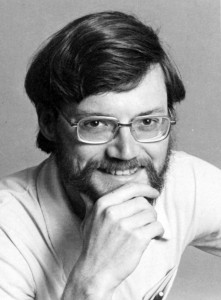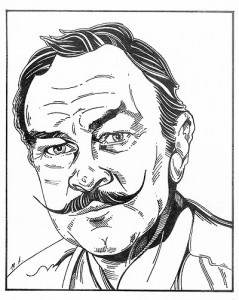The scholarship honors two NPPA members who died while working as newspaper photojournalists. Each of them inspired contributions made in their memory.
Reid Blackburn
“Photography is a small voice, at best, but sometimes – just sometimes – one photograph or a group of them can lure our senses in awareness.”
Photographer W. Eugene Smith
 These words, written on a small scrap of paper, hung in the darkroom of Reid Turner Blackburn, a photographer for The Columbian in Vancouver, Wa., and a victim of the May 18, 1980 eruption of Mount St. Helens. Above that scrap of paper with Smith’s words, Reid kept one of his favorite photographs. It was that of a wide-eyed kitten peering from a Humane Society cage, silently pleading, it seemed, for a new owner to save it from certain death (fourth picture in link).
These words, written on a small scrap of paper, hung in the darkroom of Reid Turner Blackburn, a photographer for The Columbian in Vancouver, Wa., and a victim of the May 18, 1980 eruption of Mount St. Helens. Above that scrap of paper with Smith’s words, Reid kept one of his favorite photographs. It was that of a wide-eyed kitten peering from a Humane Society cage, silently pleading, it seemed, for a new owner to save it from certain death (fourth picture in link).
Reid was working for The Columbian and donating his time to National Geographic magazine and the U.S. Geological Survey at an observation camp about seven miles from the volcano. His job was to operate radio remote-control cameras that had been placed to observe the mountain’s activity. Radio contact with Reid was broken with the Sunday morning eruption. Four days later, his body was found in his car, which was buried to its windows in ash. At the time of his death, he had been with The Columbian for five years and married to his wife, Fay, for just nine months.
He was born in Washington, D.C., on Aug. 11, 1952 and spent his early years in Maryland. His family moved to Oregon in 1962. Known for his wry humor and meticulous work, Reid first got serious about photography during his years at Wilson High School in Portland, Ore. By the time he entered Linfield College in McMinnville, Ore., he had chosen photojournalism as a career.
 Reid was an avid outdoorsman – a backpacker, bicyclist, mountain climber and cross-country skier. He had climbed Mount St. Helens several times. He belonged to the Clark County Amateur Radio Club, a hobby since childhood, and was a member of the National Press Photographer’s Association. He enjoyed music and was a self-taught accomplished musician of the guitar, mandolin and flute.
Reid was an avid outdoorsman – a backpacker, bicyclist, mountain climber and cross-country skier. He had climbed Mount St. Helens several times. He belonged to the Clark County Amateur Radio Club, a hobby since childhood, and was a member of the National Press Photographer’s Association. He enjoyed music and was a self-taught accomplished musician of the guitar, mandolin and flute.
He once wrote, “Newspaper photography, or photojournalism if you wish, offers me more than any other branch of the art. In most commercial work, feedback is from the client, and that’s about it. In a newspaper the potential for feedback is tremendously great. Each assignment is how I realize mistakes, how I find success, how I improve.” Reid felt his job was to provide informative pictures that documented life in an unbiased manner. “I have always been intrigued by magic and intricate gadgets. A camera is an absolute marvel of tiny moving parts and shiny glass … and it produces what are often magical images … pieces of unrealized history.”
View a sample of Reid Blackburn’s photographs.
A roll of Blackburn’s unprocessed film was discovered and developed in December, 2013.
Bob East
Grants honor Herald photographer
© The Miami Herald/Sunday, May 26, 1985, used by permission.
The Knight Foundation and the Miami Herald Publishing Co. have announced grants totaling $17,500 toward a photojournalism scholarship in memory of Miami Herald photographer Bob East. East, a prize-winning photographer who captured South Florida through his camera lenses for 33 years, died in March when a formaldehyde-like chemical was injected into his spine during cancer surgery.
The Bob East Photojournalism Scholarship will be awarded annually beginning in May 1986 through an endowment administered by the National Press Photographers Foundation, said Herald Executive Editor Heath Meriwether. The scholarship will be awarded to a student who intends to pursue a photojournalism career and is attending any university, although preference will be given to South Florida applicants, Meriwether said.
The Knight Foundation approved a grant of $10,000 to support the endowment for the Bob East scholarship, according to James L. Knight, chairman of the Knight Foundation and chairman emeritus of The Miami Herald.
Knight, who knew East as a colleague, described his death as the “loss of a distinguished journalist who was a compassionate human being.” said Miami Herald Publisher Richard G. Capen Jr.
“The incredible outpouring of respect and affection for Bob East under scores the enthusiasm we have for this project. It clearly is an appropriate way to memorialize his name,” Capen sa1d.
“He had a great interest in helping other people, and particularly in helping young people coming along in our profession,” Capen said. “The scholarship will perpetuate that spirit in future years.”
East, whose trademark was a waxed handlebar mustache, won dozens of local and national photography awards. Among them were the Joseph Costa Award for leadership in the National Press Photographers Association, a citation from the same association and the Burt Williams Award, given for 40 years of service.
East served as secretary of the National Press Photographers Association in 1966-67 and, during his tenure, started a national photography contest that allowed other professionals to study some of the best pictures in the country.
“He gave to his profession a gift of learning that lives today and will live in the future,” said Edward Dooks, treasurer of the National Press Photographers Foundation, which will administer the scholarship.
“Photographers have been benefitting for years because Bob East had an idea for a contest that grew into the world’s largest contest.”
Meriwether said the scholarship endowment has received a number of donations from individuals. The actual size of the scholarship from the endowment will be determined early next year, he said.
Bob East eulogized with love, laughter
by ChristineWolff, Miami News Reporter, © Miami News, March 12, 1985, used by permission.
The memory of the flamboyant man with the waxed handlebar mustache and cameras dangling from his neck in spired more laughter than tears at a memorial service in his honor.
Friends, family and colleagues gathered last night to say goodbye to veteran Miami Herald photographer Bob East, 64, who died Wednesday, four days after he was injected with a toxic substance mistaken for spinal fluid during cancer surgery at Jackson Memorial Hospital.
Some who came held handkerchiefs. But mostly there were smiles, ripples of laughter in the round sanctuary of St. Louis Catholic Church in South Dade, and tiny nods of recognition when someone described Bob East just right.
They laughed about East’s joke on his bosses – a groundbreaking picture he took years ago during ceremonies for the Herald’s building, with a stranger he planted the middle of a group of 30 Herald executives smiling over their silver-plated shovels.
“To this day, he remains unidentified,” related Herald associate editor Gene Miller.
They remembered him as the “prissy, fussy demon” in the darkroom, a man who was “instantly likeable,” a “genuinely good man, a fair man, a gentle man.”
“I keep struggling to come up with a funny line – Bob wanted people to laugh,” said Pete Weitzel, Herald managing editor. “But none of my one-liners seem to fit.”
East was someone who made the people he photographed in his 33 years with the Herald “feel good about themselves,” Miller said. He was a man who made the Herald, “sometimes a big, impersonal place, feel as comfortable as your living room,” said Heath Meriwether, Herald executive editor.
“He was a nut,” Patrick East, one of East’s seven children, fondly recalled.
“Bob is undoubtedly looking down on this with amusement,” Meriwether said. “He’s saying, ‘I’m glad I could give the columnists such rich material. And now look at all these journalists I’ve been able to get to church.”‘
To honor East, whose illness forced him in December to stop working, Meriwether said the newspaper will establish a scholarship through the Nationa! Press Photographers Association for a South Florida photojournalism student.
East was a “damn fine journalist,” Meriwether said. He “always got the picture” and always had something to add to the news story accompanying it, Meriwether said.
“It was his daughter Christina that got us started on the terrible story of his death,” Meriwether said. “She said the family felt the publicity could help keep it from happening again . . . He would have wanted us to investigate fully what happened in that operating room.”

